Intrapersonal Holograms
Paul Chivington describes a psychological hologram in his book “Seeing Through Your Illusions”. My communication models are based on Chivington’s psychological model. Communication takes place when we respond to stimulus. We store new information based upon our past experiences and what we experience in the present. Our new subconscious record will be projected in the future. Both Pribram and Chivington say that we store and project information through our subconscious mind holographically.
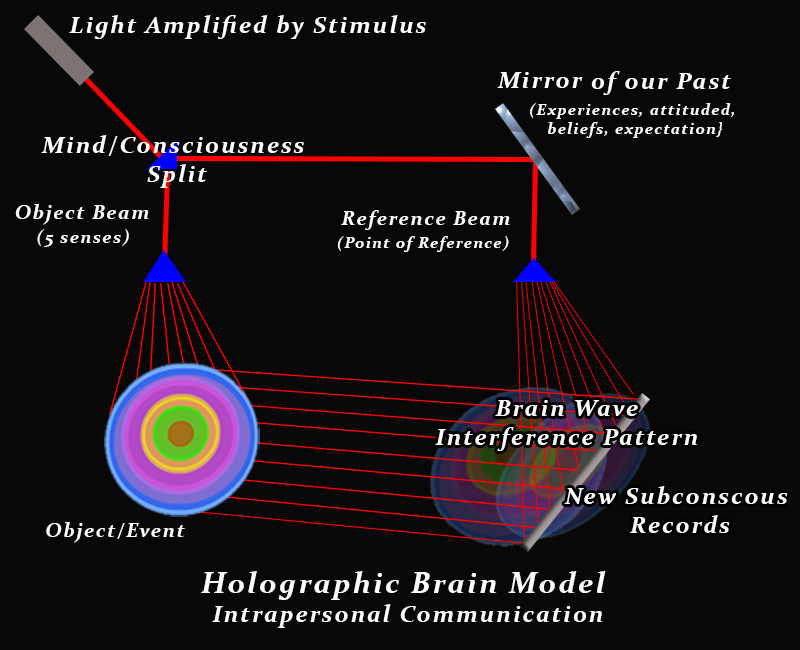
The object beam represents our 5 senses. I believe the lens represents how sharp our senses are. The lens becomes “clouded” when we loose our sensitivity to stimulus. When we reflect our sensory stimulus attention onto the object, we record the waves as a reflection of our sensory interaction.
The reference beam is a reflection of the mirror of our past experiences, beliefs, attitudes, and our expectations of the outcome of the future. It is the projection of your past hologram. The diffusion lens needs to be clear to project a clear representation of the past.
The two beams causes the interference pattern to be created in our brains. We project these old images onto future events. Chivington claims that we can change our reactions to present events by changing our attitudes and beliefs about our past experiences.
3. Projecting Information
One reference beam is used to project a hologram. A white light can be used to view, or project, most holograms. But, to get the clearest image and the most perspectives, the light source used to project the image should have a coherency similar to the original light source. The waves of the reference beam will intersect with those on the film and reproduce the information of the image. The more intersections of waves, the clearer the image reproduced.
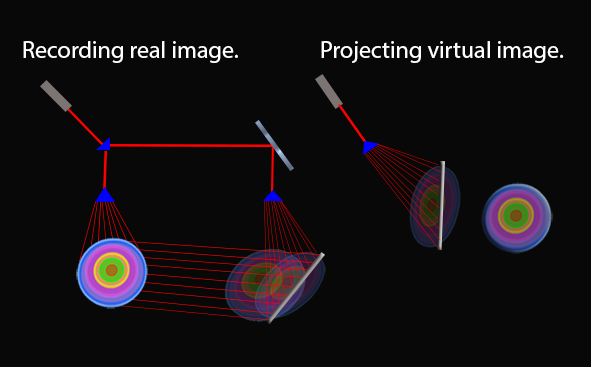
A hologram projected has an inverse relationship with the hologram recorded. Notice that the black side of the object is closest to the plate in both the real image and the virtual image.
Expanding Perspectives
The interpersonal model below shows what happens when two people view the same event. Each person records the hologram with their own intrapersonal energy coherency, or with different LASERs. They have common sensory experiences as show by the intersecting light waves from their object beams. But, each has a unique reference point, based upon information they recorded in the previous holograms.

This illustrates what happens when two people communicate about an event that they both experienced. A and B both view an event, but have different sensory experiences (object beams) and different past experiences (reference beams). They each have a unique record of the event.
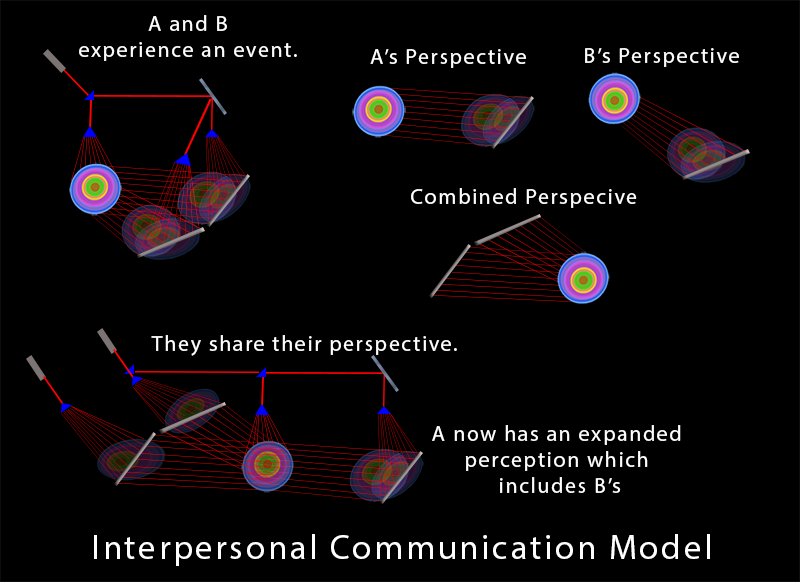
If A is able to project a clear image of his perspective, then B will be able to add the waves from A’s record’s perspective of the event. Person B will have an expanded perception of the event. If each person could coherently project their unique perspective of the event, they could enhance the clarity of each others personal holographic image by projecting or recording another wave of interference. If A communicates precisely his perspective, and B accepts the perspective and vise-versa, then the image will be clearer for both of them.
2. Projecting Virtual Images
This is an example of holographic interpersonal communication. First, person A records an event. By projecting coherent communication energy, A will be able to produce a virtual image of that event. B’s past reference beam is added to the image on memory plate. Person B can record the virtual image, and can also project to another person. If A cannot communicate at a coherent energy level, then he/she cannot re- produce the image clearly. Also, if the diffusion lens is dirty, then some of the information will not get through or some of the information could be distorted.
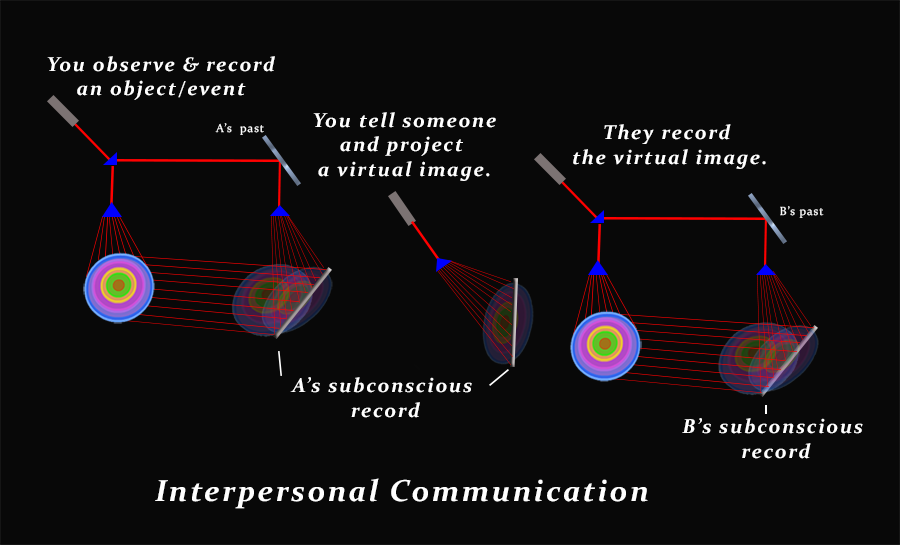
People project holographic images of their experiences using communication energy. The clarity of the image they project is dependent upon how coherent their original light source was, and how coherent the energy is that is produced by their communication efforts. Communicating at a high energy level will help to project a clearer image.
3. Quantum Memory Leaps
The whole communication process has a ripple effect as the waves expand. Each time our mind is stimulated, a wave of communication light energy is released. Any time we are stimulated by objects, events, or others’ communication light waves, we will incorporate them into our mind. The crest of each communication energy wave will expand or propagate infinitely. Holographic theory re-enforces Dance’s theory that communication is added upon. Dance’s model operates on a continuum.
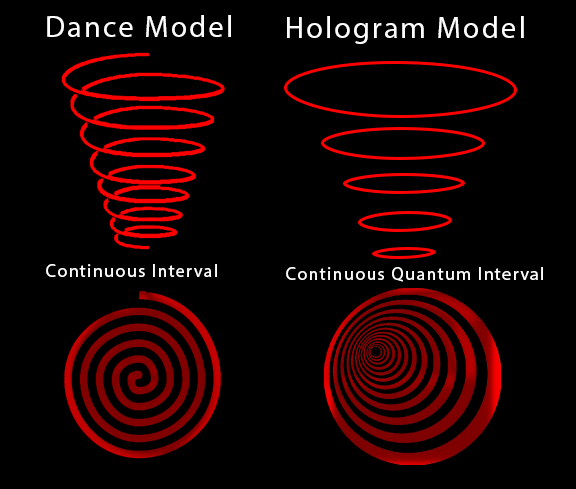
My communication model acts like the pebble’s wave which also propagates to infinity. The wave energy of communication portrays this propagation as continuous quantum leaps of information. A quanta is a measurement that deals only with whole numbers. A jump from 2 to 3, without any numbers (2.1, 2.11, 2.12..) in between. Every time we participate in communication, we record a new wave of information.
Each new memory hologram is a quantum leap.
